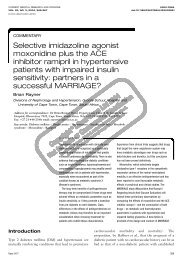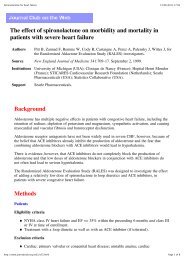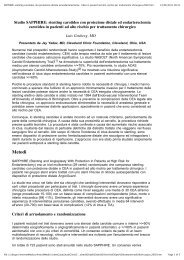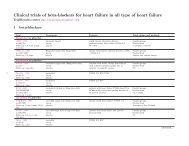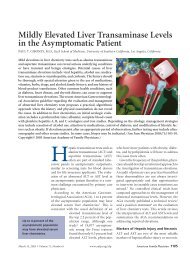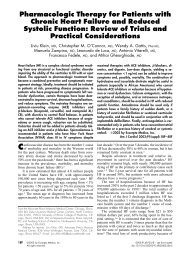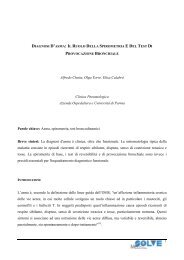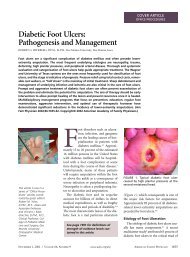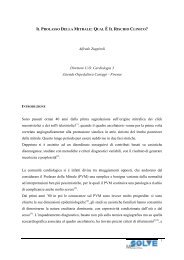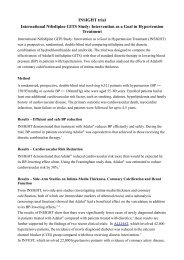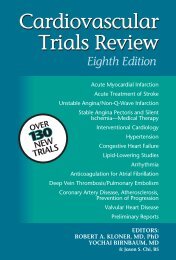EPHESUS Study (NEJM,348 (14),03042003).pdf - Diegori.it
EPHESUS Study (NEJM,348 (14),03042003).pdf - Diegori.it
EPHESUS Study (NEJM,348 (14),03042003).pdf - Diegori.it
You also want an ePaper? Increase the reach of your titles
YUMPU automatically turns print PDFs into web optimized ePapers that Google loves.
The new england<br />
journal of medicine<br />
established in 1812 april 3, 2003 vol. <strong>348</strong> no. <strong>14</strong><br />
Eplerenone, a Selective Aldosterone Blocker, in Patients<br />
w<strong>it</strong>h Left Ventricular Dysfunction after Myocardial Infarction<br />
Bertram P<strong>it</strong>t, M.D., Willem Remme, M.D., Faiez Zannad, M.D.,<br />
James Neaton, Ph.D., Felipe Martinez, M.D., Barbara Roniker, M.D., Richard B<strong>it</strong>tman, Ph.D.,<br />
Steve Hurley, B.S., Jay Kleiman, M.D., and Marjorie Gatlin, M.D., for the Eplerenone Post–Acute Myocardial<br />
Infarction Heart Failure Efficacy and Survival <strong>Study</strong> Investigators*<br />
abstract<br />
background<br />
Aldosterone blockade reduces mortal<strong>it</strong>y and morbid<strong>it</strong>y among patients w<strong>it</strong>h severe<br />
heart failure. We conducted a double-blind, placebo-controlled study evaluating the effect<br />
of eplerenone, a selective aldosterone blocker, on morbid<strong>it</strong>y and mortal<strong>it</strong>y among<br />
patients w<strong>it</strong>h acute myocardial infarction complicated by left ventricular dysfunction<br />
and heart failure.<br />
methods<br />
Patients were randomly assigned to eplerenone (25 mg per day in<strong>it</strong>ially, t<strong>it</strong>rated to a<br />
maximum of 50 mg per day; 3313 patients) or placebo (3319 patients) in add<strong>it</strong>ion to optimal<br />
medical therapy. The study continued until 1012 deaths occurred. The primary end<br />
points were death from any cause and death from cardiovascular causes or hosp<strong>it</strong>alization<br />
for heart failure, acute myocardial infarction, stroke, or ventricular arrhythmia.<br />
results<br />
During a mean follow-up of 16 months, there were 478 deaths in the eplerenone group<br />
and 554 deaths in the placebo group (relative risk, 0.85; 95 percent confidence interval,<br />
0.75 to 0.96; P=0.008). Of these deaths, 407 in the eplerenone group and 483 in the placebo<br />
group were attributed to cardiovascular causes (relative risk, 0.83; 95 percent confidence<br />
interval, 0.72 to 0.94; P=0.005). The rate of the other primary end point, death<br />
from cardiovascular causes or hosp<strong>it</strong>alization for cardiovascular events, was reduced by<br />
eplerenone (relative risk, 0.87; 95 percent confidence interval, 0.79 to 0.95; P=0.002), as<br />
was the secondary end point of death from any cause or any hosp<strong>it</strong>alization (relative<br />
risk, 0.92; 95 percent confidence interval, 0.86 to 0.98; P=0.02). There was also a reduction<br />
in the rate of sudden death from cardiac causes (relative risk, 0.79; 95 percent confidence<br />
interval, 0.64 to 0.97; P=0.03). The rate of serious hyperkalemia was 5.5 percent<br />
in the eplerenone group and 3.9 percent in the placebo group (P=0.002), whereas<br />
the rate of hypokalemia was 8.4 percent in the eplerenone group and 13.1 percent in<br />
the placebo group (P
The new england journal of medicine<br />
defin<strong>it</strong>ion of study end points<br />
The two primary end points were time to death from<br />
any cause and time to death from cardiovascular<br />
causes or first hosp<strong>it</strong>alization for a cardiovascular<br />
event, including heart failure, recurrent acute myocardial<br />
infarction, stroke, or ventricular arrhythmia.<br />
The major secondary end points were death from<br />
cardiovascular causes and death from any cause or<br />
any hosp<strong>it</strong>alization. All end points were adjudicataldosterone<br />
blockade reduces the<br />
rate of death due to progressive heart failure<br />
and the rate of sudden death from cardiac<br />
causes, as well as the rate of hosp<strong>it</strong>alizations<br />
for heart failure, among patients w<strong>it</strong>h severe heart<br />
failure due to systolic left ventricular dysfunction<br />
who are being treated w<strong>it</strong>h an angiotensin-converting–enzyme<br />
(ACE) inhib<strong>it</strong>or. 1 Aldosterone blockade<br />
also prevents ventricular remodeling and collagen<br />
formation in patients w<strong>it</strong>h left ventricular dysfunction<br />
after acute myocardial infarction 2 and affects<br />
a number of pathophysiological mechanisms that<br />
are thought to be important in the prognosis of patients<br />
w<strong>it</strong>h acute myocardial infarction. 3-12 Its role<br />
in reducing mortal<strong>it</strong>y and the rate of hosp<strong>it</strong>alization<br />
among patients w<strong>it</strong>h acute myocardial infarction<br />
complicated by left ventricular dysfunction is uncertain.<br />
We therefore designed the Eplerenone Post–<br />
Acute Myocardial Infarction Heart Failure Efficacy<br />
and Survival <strong>Study</strong> (<strong>EPHESUS</strong>) to test the hypothesis<br />
that treatment w<strong>it</strong>h eplerenone, an aldosterone<br />
blocker that selectively blocks the mineralocorticoid<br />
receptor and not glucocorticoid, progesterone, or<br />
androgen receptors, 13 reduces overall mortal<strong>it</strong>y and<br />
cardiovascular mortal<strong>it</strong>y or hosp<strong>it</strong>alization for cardiovascular<br />
events among patients w<strong>it</strong>h acute myocardial<br />
infarction complicated by left ventricular<br />
dysfunction and heart failure who are receiving optimal<br />
medical therapy.<br />
methods<br />
study design and study population<br />
We conducted a multicenter, international, randomized,<br />
double-blind, placebo-controlled trial. <strong>14</strong> Patients<br />
were randomly assigned to receive eplerenone<br />
(25 mg per day) or matching placebo for four weeks,<br />
after which the dose of eplerenone was increased<br />
to a maximum of 50 mg per day. Randomization<br />
was stratified according to clinical s<strong>it</strong>e, and schedules<br />
were prepared w<strong>it</strong>h the use of permuted blocks<br />
to ensure the ongoing equivalence of the size of the<br />
groups. If at any time during the study the serum<br />
potassium concentration was higher than 5.5 mmol<br />
per l<strong>it</strong>er, the dose of the study drug was reduced or<br />
treatment was temporarily discontinued until the<br />
serum potassium concentration fell below 5.5 mmol<br />
per l<strong>it</strong>er.<br />
Patients in whom the following cr<strong>it</strong>eria were met<br />
were eligible for randomization 3 to <strong>14</strong> days after<br />
acute myocardial infarction: acute myocardial infarction<br />
as documented according to standard cr<strong>it</strong>eria;<br />
left ventricular dysfunction as documented<br />
by a left ventricular ejection fraction of 40 percent or<br />
lower on echocardiography, radionuclide angiography,<br />
or angiography of the left ventricle after the<br />
index acute myocardial infarction and before randomization;<br />
and heart failure as documented by the<br />
presence of pulmonary rales, chest radiography<br />
showing pulmonary venous congestion, or the presence<br />
of a third heart sound. In patients w<strong>it</strong>h diabetes<br />
who met the cr<strong>it</strong>eria for left ventricular dysfunction<br />
after acute myocardial infarction, symptoms of<br />
heart failure did not have to be demonstrated, since<br />
such patients have an increased risk of cardiovascular<br />
events similar to that of nondiabetic patients<br />
w<strong>it</strong>h symptoms of heart failure. 15 Patients received<br />
optimal medical therapy, which could include ACE<br />
inhib<strong>it</strong>ors, angiotensin-receptor blockers, diuretics,<br />
and beta-blockers, as well as coronary reperfusion<br />
therapy.<br />
Important cr<strong>it</strong>eria for exclusion were the use of<br />
potassium-sparing diuretics, a serum creatinine<br />
concentration of more than 2.5 mg per decil<strong>it</strong>er<br />
(220 µmol per l<strong>it</strong>er), and a serum potassium concentration<br />
of more than 5.0 mmol per l<strong>it</strong>er before<br />
randomization. The inst<strong>it</strong>utional review board or<br />
ethics comm<strong>it</strong>tee at each s<strong>it</strong>e approved the protocol,<br />
and all patients provided wr<strong>it</strong>ten informed consent<br />
before enrollment.<br />
Screening and base-line procedures were to be<br />
performed during the hosp<strong>it</strong>alization for the index<br />
acute myocardial infarction, and follow-up vis<strong>it</strong>s<br />
occurred at one and four weeks, three months, and<br />
every three months thereafter until the termination<br />
of the study. The serum potassium concentration<br />
was measured 48 hours after the in<strong>it</strong>iation of treatment,<br />
at one, four, and five weeks, at all scheduled<br />
study vis<strong>it</strong>s, and w<strong>it</strong>hin one week after any change<br />
of dose. Information about adverse events and concurrent<br />
medications was recorded at every vis<strong>it</strong>. All<br />
patients who underwent randomization were followed<br />
for v<strong>it</strong>al status and hosp<strong>it</strong>alizations every<br />
three months until the termination of the study.<br />
1310<br />
n engl j med <strong>348</strong>;<strong>14</strong> www.nejm.org april 3, 2003<br />
Downloaded from www.nejm.org at UNIV MINN / BIOMED LIB COPY 1 on May <strong>14</strong>, 2003.<br />
For personal or educational use only. No other uses w<strong>it</strong>hout permission. All rights reserved.
eplerenone, a selective aldosterone blocker, after myocardial infarction<br />
ed by a blinded cr<strong>it</strong>ical-events comm<strong>it</strong>tee. Defin<strong>it</strong>ions<br />
of all adjudicated end points are presented in<br />
Supplementary Appendix 1 (available w<strong>it</strong>h the full<br />
text of this article at http://www. nejm.org).<br />
statistical analysis<br />
The two groups were compared in terms of the two<br />
primary end points and the secondary end points<br />
w<strong>it</strong>h the use of Cox proportional-hazards regression.<br />
The Cox model included a single covariate corresponding<br />
to treatment group and was stratified<br />
according to geographic region (Canada and the<br />
Un<strong>it</strong>ed States, Latin America, eastern Europe, western<br />
Europe, and the rest of the world [including<br />
Australia, Israel, New Zealand, South Africa, South<br />
Korea, and Taiwan]). The model was used to estimate<br />
the relative risk and corresponding 95 percent<br />
confidence interval. Time-to-event distributions<br />
were summarized w<strong>it</strong>h Kaplan–Meier curves. For<br />
analyses of mortal<strong>it</strong>y, data were censored at the<br />
time of loss to follow-up or on the closing date of<br />
the study (August 30, 2002). For analyses of death<br />
from cardiovascular causes or hosp<strong>it</strong>alization for<br />
cardiovascular events, data were censored at the<br />
time of death due to noncardiovascular causes,<br />
the time of loss to follow-up, or on the closing date<br />
of the study. Analyses of the primary and secondary<br />
end points were conducted according to the intention-to-treat<br />
principle.<br />
The trial was designed to enroll 6200 patients<br />
and to continue until 1012 deaths occurred. To<br />
maintain an overall type I error rate of 0.05 (twosided),<br />
the rate of death from any cause was tested<br />
at the 0.04 level of significance and the rate of death<br />
from cardiovascular causes or hosp<strong>it</strong>alization for<br />
cardiovascular events was tested at the 0.01 level of<br />
significance. W<strong>it</strong>h testing at the 0.04 level of significance<br />
(two-sided), the study had 88.3 percent power<br />
to detect an 18.5 percent difference between the<br />
two groups in the rate of death from any cause. 16 An<br />
external data and safety mon<strong>it</strong>oring board conducted<br />
four interim analyses; an alpha level of 0.0001<br />
was the threshold for early termination in the first<br />
two interim analyses of mortal<strong>it</strong>y from any cause,<br />
and an alpha level of 0.001 was the threshold for<br />
the last two analyses. Data-base management was<br />
performed by a contract research organization. The<br />
interim analyses were conducted by an independent<br />
statistician for the data and safety mon<strong>it</strong>oring board.<br />
All final analyses were conducted by the sponsor. All<br />
independent authors had a substantial role in trial<br />
design, data accrual, and data interpretation. All had<br />
complete access to the data after unblinding.<br />
Subgroup analyses for the two primary end points<br />
were performed w<strong>it</strong>h a Cox model stratified according<br />
to region, w<strong>it</strong>h terms for treatment, subgroup,<br />
and interaction between treatment and subgroup.<br />
For these analyses, measured variables were treated<br />
as binary variables, dichotomized at the median value,<br />
and also considered as continuous variables.<br />
We also used Cox regression to summarize the<br />
time to first hosp<strong>it</strong>alization for a cardiovascular<br />
event. For these analyses, data were censored at the<br />
time of death. The frequencies of hosp<strong>it</strong>alization<br />
for particular causes were analyzed by means of a<br />
Cochran–Mantel–Haenszel test, and the relative<br />
risk for this analysis was reported as the ratio of<br />
the number of hosp<strong>it</strong>alizations per patient in the<br />
eplerenone group to the number of hosp<strong>it</strong>alizations<br />
per patient in the placebo group. The number of<br />
patients who would need to be treated to prevent<br />
one event was determined by the method of Altman<br />
and Andersen. 17<br />
All patients who received at least one dose of<br />
the study medication were included in the safety<br />
analyses, which included analyses of adverse events,<br />
v<strong>it</strong>al signs, and results of clinical laboratory tests.<br />
Changes in v<strong>it</strong>al signs and clinical laboratory values<br />
were assessed by analysis of covariance, w<strong>it</strong>h the<br />
base-line value as a covariate. Creatinine clearance<br />
was calculated according to the Cockcroft–Gault<br />
formula. 18 All reported P values are two-sided and<br />
are not adjusted for the interim analyses.<br />
results<br />
study patients<br />
A total of 6642 patients underwent randomization<br />
at 674 centers in 37 countries between December<br />
27, 1999, and December 31, 2001. A total of 3313<br />
were assigned to placebo, 3319 were assigned to<br />
eplerenone, and 10 were excluded from the analysis<br />
before unblinding because of problems w<strong>it</strong>h the<br />
qual<strong>it</strong>y of the data at one center. There were no significant<br />
differences between the two groups at base<br />
line (Table 1). At base line, the major<strong>it</strong>y of patients<br />
were receiving standard therapies for acute myocardial<br />
infarction complicated by left ventricular dysfunction<br />
and heart failure, including ACE inhib<strong>it</strong>ors<br />
or angiotensin-receptor blockers (in 87 percent of<br />
patients), beta-blockers (in 75 percent), aspirin (in<br />
88 percent), and diuretics (in 60 percent).<br />
Twelve patients in each treatment group did not<br />
take any study medication. During the study, 1021<br />
patients (493 in the placebo group and 528 in the<br />
eplerenone group) permanently discontinued the<br />
n engl j med <strong>348</strong>;<strong>14</strong> www.nejm.org april 3, 2003<br />
1311<br />
Downloaded from www.nejm.org at UNIV MINN / BIOMED LIB COPY 1 on May <strong>14</strong>, 2003.<br />
For personal or educational use only. No other uses w<strong>it</strong>hout permission. All rights reserved.
The new england journal of medicine<br />
study medication (median time from randomization<br />
to the last dose, 98 days). The most frequent<br />
reasons were a request by the patient to w<strong>it</strong>hdraw<br />
from the study (in 204 patients in the placebo group<br />
and 231 in the eplerenone group) and adverse events<br />
Table 1. Base-Line Characteristics of the Patients.*<br />
Characteristic<br />
Eplerenone<br />
Group<br />
(N=3319)<br />
Placebo<br />
Group<br />
(N=3313)<br />
Age — yr 64±11 64±12<br />
Race — no. (%)†<br />
Wh<strong>it</strong>e<br />
Black<br />
Other<br />
Sex — no. (%)<br />
Male<br />
Female<br />
Blood pressure — mm Hg<br />
Systolic<br />
Diastolic<br />
2995 (90)<br />
30 (1)<br />
294 (9)<br />
2380 (72)<br />
939 (28)<br />
119±17<br />
72±11<br />
2989 (90)<br />
44 (1)<br />
280 (8)<br />
2334 (70)<br />
979 (30)<br />
119±17<br />
72±11<br />
Left ventricular ejection fraction — % 33±6 33±6<br />
Days from myocardial infarction to randomization<br />
Previous hosp<strong>it</strong>alization for heart failure<br />
— %<br />
Reperfusion therapy or revascularization<br />
— %<br />
7.3±3.0 7.3±3.0<br />
7 8<br />
45 45<br />
Symptoms of heart failure — % 90 90<br />
Serum potassium concentration<br />
— mmol/l<strong>it</strong>er<br />
4.3±0.4 4.3±0.5<br />
Serum creatinine concentration — mg/dl‡ 1.1±0.3 1.1±0.3<br />
Creatinine clearance — ml/min 79±60 78±57<br />
Medical history — %<br />
Acute myocardial infarction<br />
Diabetes<br />
Heart failure<br />
Hypertension<br />
Medications — %§<br />
ACE inhib<strong>it</strong>or or angiotensin-receptor<br />
blocker<br />
Beta-blockers<br />
Diuretics<br />
Aspirin<br />
Statins<br />
* Plus–minus values are means ±SD. ACE denotes angiotensin-converting<br />
enzyme.<br />
† Race was self-reported by patients.<br />
‡ To convert values for creatinine to micromoles per l<strong>it</strong>er, multiply by 88.4.<br />
§ Data are for medications taken at randomization or up to <strong>14</strong> days after the index<br />
acute myocardial infarction.<br />
27<br />
32<br />
<strong>14</strong><br />
60<br />
86<br />
75<br />
60<br />
88<br />
47<br />
27<br />
32<br />
15<br />
61<br />
87<br />
75<br />
61<br />
89<br />
47<br />
(in <strong>14</strong>9 patients in the placebo group and <strong>14</strong>7 in the<br />
eplerenone group). Seventeen patients (7 in the placebo<br />
group and 10 in the eplerenone group) had unknown<br />
v<strong>it</strong>al status on the closing date of the study<br />
(August 30, 2002), and 99 percent of the surviving<br />
patients were seen or contacted between August<br />
15 and August 30, 2002. The mean duration of follow-up<br />
was 16 months (range, 0 to 33). The mean<br />
dose-equivalent of study medication was 43.5 mg<br />
in the placebo group and 42.6 mg in the eplerenone<br />
group.<br />
end points<br />
A total of 478 patients in the eplerenone group<br />
(<strong>14</strong>.4 percent) and 554 patients in the placebo group<br />
(16.7 percent) died (relative risk, 0.85; P=0.008)<br />
(Table 2). Kaplan–Meier estimates of mortal<strong>it</strong>y at<br />
one year were 11.8 percent in the eplerenone group<br />
and 13.6 percent in the placebo group (Fig. 1A).<br />
The end point of death from cardiovascular causes<br />
or hosp<strong>it</strong>alization for cardiovascular events was<br />
reached by 885 patients in the eplerenone group<br />
(26.7 percent) and 993 patients in the placebo group<br />
(30.0 percent) (relative risk, 0.87; P=0.002) (Fig. 1B).<br />
A total of 407 deaths in the eplerenone group<br />
(12.3 percent of patients) and 483 deaths in the placebo<br />
group (<strong>14</strong>.6 percent of patients) were attributed<br />
to cardiovascular causes (relative risk, 0.83;<br />
P=0.005). The reduction in cardiovascular mortal<strong>it</strong>y<br />
was similar for the most common causes — sudden<br />
death from cardiac causes, acute myocardial<br />
infarction, and heart failure (range of relative risks,<br />
0.79 to 0.82). Of these reductions, the reduction in<br />
the risk of sudden death from cardiac causes was<br />
statistically significant (relative risk, 0.79; P=0.03)<br />
(Table 2 and Fig. 1C). There was a relative reduction<br />
of 15 percent in the risk of hosp<strong>it</strong>alization for heart<br />
failure w<strong>it</strong>h eplerenone (relative risk, 0.85; P=0.03),<br />
and there were 23 percent fewer episodes of hosp<strong>it</strong>alization<br />
for heart failure in the eplerenone group<br />
than in the placebo group (relative risk, 0.77; P=<br />
0.002). The rate of death from any cause or any hosp<strong>it</strong>alization<br />
was 8 percent lower in the eplerenone<br />
group than in the placebo group (relative risk, 0.92;<br />
P=0.02).<br />
The relative risks for important predefined subgroups<br />
are shown in Figure 2. Reductions in the<br />
rate of death from any cause and the rate of death<br />
from cardiovascular causes or hosp<strong>it</strong>alization for<br />
cardiovascular events were consistent among subgroups.<br />
Interactions between treatment and some<br />
measured variables were significant when they<br />
1312<br />
n engl j med <strong>348</strong>;<strong>14</strong> www.nejm.org april 3, 2003<br />
Downloaded from www.nejm.org at UNIV MINN / BIOMED LIB COPY 1 on May <strong>14</strong>, 2003.<br />
For personal or educational use only. No other uses w<strong>it</strong>hout permission. All rights reserved.
eplerenone, a selective aldosterone blocker, after myocardial infarction<br />
Table 2. Summary of Primary and Secondary End Points.*<br />
Variable<br />
Eplerenone<br />
Group<br />
(N=3319)<br />
Placebo<br />
Group<br />
(N=3313)<br />
Relative Risk<br />
(95% CI)<br />
or Ratio†<br />
P<br />
Value<br />
Primary end points<br />
Death from any cause (no. of patients) 478 554 0.85 (0.75–0.96) 0.008<br />
Death from cardiovascular causes or hosp<strong>it</strong>alization<br />
for cardiovascular<br />
events (no. of patients)<br />
885 993 0.87 (0.79–0.95) 0.002<br />
Secondary end points<br />
Death from any cause or any hosp<strong>it</strong>alization<br />
(no. of patients)<br />
Death from cardiovascular causes (no. of<br />
patients)<br />
1730 1829 0.92 (0.86–0.98) 0.02<br />
407 483 0.83 (0.72–0.94) 0.005<br />
Sudden death from cardiac causes 162 201 0.79 (0.64–0.97) 0.03<br />
Acute myocardial infarction 78 94 0.82 (0.61–1.10) 0.19<br />
Heart failure 104 127 0.80 (0.62–1.04) 0.10<br />
Stroke 26 28 0.91 (0.53–1.55) 0.73<br />
Other 37 33 1.00 (0.60–1.66) 0.99<br />
Any hosp<strong>it</strong>alization (no. of patients) <strong>14</strong>93 1526 0.95 (0.89–1.02) 0.20<br />
Hosp<strong>it</strong>alization for cardiovascular events<br />
(no. of patients)<br />
606 649 0.91 (0.81–1.01) 0.09<br />
Acute myocardial infarction 224 229 0.97 (0.80–1.16) 0.71<br />
Heart failure 345 391 0.85 (0.74–0.99) 0.03<br />
Stroke 70 51 1.34 (0.94–1.93) 0.11<br />
Ventricular arrhythmia 52 54 0.95 (0.65–1.39) 0.79<br />
Any hosp<strong>it</strong>alization (no. of episodes) 2815 2984 0.94 0.12<br />
Hosp<strong>it</strong>alization for cardiovascular events<br />
(no. of episodes)<br />
876 1004 0.87 0.03<br />
Acute myocardial infarction 268 269 0.99 0.96<br />
Heart failure 477 618 0.77 0.002<br />
Stroke 73 54 1.35 0.11<br />
Ventricular arrhythmia 58 63 0.92 0.69<br />
* Hosp<strong>it</strong>alizations were defined as nonfatal events causing or prolonging hosp<strong>it</strong>alization. CI denotes confidence interval.<br />
† Numbers w<strong>it</strong>hout confidence intervals are the ratios of the number of hosp<strong>it</strong>alizations per patient in the eplerenone<br />
group to the number of hosp<strong>it</strong>alizations per patient in the placebo group.<br />
were analyzed as binary variables w<strong>it</strong>h median cutoff<br />
points (e.g., pulse pressure), but when they were<br />
considered as continuous variables, the interactions<br />
were no longer significant. The beneficial effect of<br />
eplerenone was also consistent across geographic<br />
regions (P= 0.24 for the interaction of treatment<br />
and region for death from any cause, and P=0.94 for<br />
the interaction of treatment and region for death<br />
from cardiovascular causes or hosp<strong>it</strong>alization for<br />
cardiovascular events).<br />
safety<br />
After week 1, the mean systolic and diastolic blood<br />
pressure increased in both groups from base line<br />
to each time point throughout the remainder of<br />
the trial. The magn<strong>it</strong>ude of these increases in the<br />
n engl j med <strong>348</strong>;<strong>14</strong> www.nejm.org april 3, 2003<br />
1313<br />
Downloaded from www.nejm.org at UNIV MINN / BIOMED LIB COPY 1 on May <strong>14</strong>, 2003.<br />
For personal or educational use only. No other uses w<strong>it</strong>hout permission. All rights reserved.
The new england journal of medicine<br />
A<br />
B<br />
C<br />
Cumulative Incidence (%)<br />
No. at Risk<br />
Placebo<br />
Eplerenone<br />
Cumulative Incidence (%)<br />
No. at Risk<br />
Placebo<br />
Eplerenone<br />
Cumulative Incidence (%)<br />
No. at Risk<br />
Placebo<br />
Eplerenone<br />
40<br />
35<br />
30<br />
25<br />
Placebo<br />
20<br />
15<br />
Eplerenone<br />
10<br />
5<br />
0<br />
0 3 6 9 12 15 18 21 24 27 30 33 36<br />
Months since Randomization<br />
3313<br />
3319<br />
3313<br />
3319<br />
P=0.008<br />
RR=0.85 (95% CI, 0.75–0.96)<br />
3064<br />
3125<br />
2754<br />
2816<br />
2983<br />
3044<br />
2580<br />
2680<br />
2830<br />
2896<br />
2388<br />
2504<br />
2418<br />
2463<br />
2013<br />
2096<br />
1801<br />
1857<br />
<strong>14</strong>94<br />
1564<br />
1213<br />
1260<br />
995<br />
1061<br />
709<br />
728<br />
558<br />
594<br />
323<br />
336<br />
247<br />
273<br />
99<br />
110<br />
40<br />
P=0.002<br />
Placebo<br />
35 RR=0.87 (95% CI, 0.79–0.95)<br />
30<br />
Eplerenone<br />
25<br />
20<br />
15<br />
10<br />
5<br />
0<br />
0 3 6 9 12 15 18 21 24 27 30 33 36<br />
Months since Randomization<br />
10<br />
P=0.03<br />
9<br />
RR=0.79 (95% CI, 0.64–0.97)<br />
Placebo<br />
8<br />
7<br />
6<br />
Eplerenone<br />
5<br />
4<br />
3<br />
2<br />
1<br />
0<br />
0 3 6 9 12 15 18 21 24 27 30 33 36<br />
Months since Randomization<br />
3313<br />
3319<br />
3064<br />
3125<br />
2983<br />
3044<br />
2830<br />
2896<br />
2418<br />
2463<br />
1801<br />
1857<br />
1213<br />
1260<br />
709<br />
728<br />
323<br />
336<br />
77<br />
91<br />
99<br />
110<br />
2<br />
0<br />
2<br />
0<br />
2<br />
0<br />
0<br />
0<br />
0<br />
0<br />
0<br />
0<br />
0<br />
0<br />
0<br />
0<br />
0<br />
0<br />
Figure 1. Kaplan–Meier Estimates of the Rate of Death from Any Cause (Panel A), the Rate of Death from Cardiovascular<br />
Causes or Hosp<strong>it</strong>alization for Cardiovascular Events (Panel B), and the Rate of Sudden Death from Cardiac Causes (Panel C).<br />
RR denotes relative risk, and CI confidence interval.<br />
13<strong>14</strong><br />
n engl j med <strong>348</strong>;<strong>14</strong> www.nejm.org april 3, 2003<br />
Downloaded from www.nejm.org at UNIV MINN / BIOMED LIB COPY 1 on May <strong>14</strong>, 2003.<br />
For personal or educational use only. No other uses w<strong>it</strong>hout permission. All rights reserved.
eplerenone, a selective aldosterone blocker, after myocardial infarction<br />
eplerenone group was significantly smaller than<br />
that in the placebo group at every point. At one year,<br />
the mean blood pressure had increased by 8/4<br />
mm Hg in the placebo group and by 5/3 mm Hg in<br />
the eplerenone group (P
The new england journal of medicine<br />
A<br />
Death from any cause<br />
Sex<br />
Male<br />
Female<br />
Age<br />
eplerenone, a selective aldosterone blocker, after myocardial infarction<br />
B<br />
Death from cardiovascular causes<br />
or hosp<strong>it</strong>alization for cardiovascular<br />
events<br />
Sex<br />
Male<br />
Female<br />
Age<br />
The new england journal of medicine<br />
Table 3. Adverse Events.<br />
Adverse Event<br />
Eplerenone<br />
Group<br />
(N=3307)<br />
Placebo<br />
Group<br />
(N=3301)<br />
no. of patients (%)<br />
P<br />
Value<br />
≥1 Event 2608 (78.9) 2623 (79.5) 0.57<br />
Cardiovascular disorder* 1606 (48.6) 1661 (50.3) 0.16<br />
Respiratory disorder 729 (22.0) 803 (24.3) 0.03<br />
Cough 167 (5.0) 207 (6.3) 0.03<br />
Dyspnea 243 (7.3) 307 (9.3) 0.004<br />
Pneumonia 92 (2.8) 123 (3.7) 0.03<br />
Metabolic or nutr<strong>it</strong>ional disorder 568 (17.2) 635 (19.2) 0.03<br />
Hyperkalemia† 113 (3.4) 66 (2.0)
eplerenone, a selective aldosterone blocker, after myocardial infarction<br />
— all factors known to have important effects on<br />
the risk of sudden death from cardiac causes.<br />
Eplerenone was beneficial in patients who were<br />
receiving optimal therapy including an ACE inhib<strong>it</strong>or<br />
or angiotensin-receptor blocker, a beta-blocker,<br />
aspirin, a lipid-lowering agent, and coronary reperfusion<br />
therapy. Previous experience w<strong>it</strong>h regard<br />
to the effectiveness of aldosterone blockade in patients<br />
w<strong>it</strong>h left ventricular dysfunction who are receiving<br />
an ACE inhib<strong>it</strong>or and a beta-blocker is<br />
lim<strong>it</strong>ed, in that in RALES the proportion of patients<br />
who were treated w<strong>it</strong>h a beta-blocker was only 11<br />
percent. 1 This difference in treatments is important,<br />
because ACE inhib<strong>it</strong>ors and beta-blockers are<br />
considered to represent the current standard of care<br />
in patients w<strong>it</strong>h left ventricular dysfunction after<br />
acute myocardial infarction, and other treatments,<br />
including endothelin-receptor antagonists, antibodies<br />
against tumor necrosis factor a, and angiotensin-receptor<br />
blockers, have not been found to reduce<br />
mortal<strong>it</strong>y among patients w<strong>it</strong>h left ventricular<br />
dysfunction and heart failure who are being treated<br />
w<strong>it</strong>h an ACE inhib<strong>it</strong>or and a beta-blocker.<br />
We examined a number of predefined subgroups,<br />
but our trial was not designed w<strong>it</strong>h sufficient power<br />
to draw statistical conclusions about individual subgroups.<br />
Thus, one should be cautious in interpreting<br />
the results of subgroup analyses. There were a<br />
few subgroups in which we found a nominally significant<br />
interaction w<strong>it</strong>h treatment, but no interaction<br />
we examined had a significant effect on both<br />
primary end points. In general, the beneficial effect<br />
of eplerenone on the two primary end points was<br />
consistent.<br />
There was an increased incidence of serious hyperkalemia<br />
among patients assigned to eplerenone.<br />
The risk of serious hyperkalemia was significantly<br />
increased among patients who had a decreased creatinine<br />
clearance at base line (
The new england journal of medicine<br />
A. Parkhomenko, B. P<strong>it</strong>t (chair), H. Ross, J. Stepinska, C. Torp-Pedersen, W. Van Mieghem, D.-J. van Veldhuisen, H. Wh<strong>it</strong>e, R.G. Wilcox, R.<br />
Willenbrock, Y.-T. Yotov, and F. Zannad. Data and Safety Mon<strong>it</strong>oring Board: J.-P. Boissel, C. Furberg, D. Julian (chair), H. Kulbertus, S. Pocock,<br />
and J. W<strong>it</strong>tes (statistical consultant). Cr<strong>it</strong>ical Events Comm<strong>it</strong>tee: A. Battler, J. Blumenfeld, C. Brilla, D. Duprez, M. Fowler, A. Gavazzi, P. Hildebrandt,<br />
M. Komajda, J. Korewicki, D. Kosturakis, J.A. Marin-Neto, A. Miller, R. Muñoz Aguilera, R. Oliveri, W. Remme (chair), M. Wh<strong>it</strong>e,<br />
and P. Widimsky. Scientific Advisory Board: G. Bakris, A. Castaigne, P. Deedwania, D. Duprez, J.M. Ketelslegers, P. Liu, G. Mancia, J. Nicklas,<br />
J.-L. Rouleau, L. Ruilope, S. Sasayama, E. Schiffrin, J. Spertus, A. Struthers, D. Vaughan, M. Weber, and G. Williams (chair). Investigators:<br />
Europe — E. Abinader, J. Adams, P.C. Adams, J. Adamus, P. Ahlstrom, H.S. Akesson, N. Akhmedzhanov, S. Alcasena Juango, S. Ali Khan,<br />
A. Alonso Garcia, G. Amat, J. Amerena, K.M. Amosova, L. Andreoli, K. Angelo-Nielsen, J. Antonio de Velasco, E. Apetrei, G. Aroutiounov,<br />
M. Aschermann, M. Asklund, I. Assmann, M.-C. Aumont, A. Avtandilov, O. Azarin, V. Bada, P. Bakoumov, I. Balazovjech, E. Baldjiev,<br />
M. Baluda, J.R. Barrazueta, B. Barsi, Y. Bashir, P.D. Batin, D. Belenky, Y. Belyi, P.E.F. Bendermacher, K. Berget, C. Bergmeier, J. Berning, J.R.<br />
Berrazueta-Fernendez, P. Block, G. Boberg, P. Bocek, V. Bohlscheid, I. Bokarev, H. Bolinska, K. Boman, S. Bondarev, T. Bonzel, J.-L.<br />
Boreux, M. Borggrefe, M. Borisov, G. Boxho, M. Boyarkin, J. Brachmann, M. Brack, I. Branea, K. Breivik, G.S. Brigden, P.N.A. Bronzwaer,<br />
D. Bruce, I. Bruckner, H. Brunvand, A. Bryukhovetski, P. Buser, T. Campbell, A. Campeanu, A. Capucci, E. Carasca, J. Cardoso, M. Carrageta,<br />
A. Caspi, S. Cassim, J. Caturla, F. Ceia, B. Cernosek, K. Channer, Z. Chati, P.D. Christensen, N.S. Chung, M. Cinteza, J.G.F. Cleland, M.<br />
Cocchieri, P. Commerford, U. Conti, G. Corsini, A. Cortina Liosa, J.-M. Coupez, A. Cribier, J. Csillag, J. Cyran, U. Dahlstrom, A. Dalby, L.J.<br />
Dalin, M. Dalkowski, H.J. Dargie, H. Darius, D.M. Datcu, D. David, M. De Myttenaere, E. De Teresa, J. De Velasco, A.G. de Vries, F.R. den<br />
Hartog, E. Desjoyaux, A. Dezerbi, J. Dhawan, B. Diaz Molina, K. Dickstein, M. Dorobantu, V. Dosch<strong>it</strong>sin, A. Doubell, P. Dovgalevsky, S.I.<br />
Dragulescu, O. Drapkina, O. Dubourg, P.H.J.M. Dunselman, O.I. Dyadyk, Y.V. Dykun, G.V. Dzyak, L.P. Egorova, K. Egstrup, J. Eha, M.<br />
Ehrenbergerova, D. El Allaf, A. Elenkova, C.J. Ellis, J.G. Engbers, A.F. Fainyk, G. Falck, R. Fanelli, J. Farre -Mun, J. Favier, G. Ferrari, I. Ferreira,<br />
H. Fischer, S. Fotyanov, M.P. Freericks, G. Froeland, E. Galve, M.M. Garcia, A.A. Garcia, L.F. Garnier, G. Gazaryan, C. Georgescu, J.<br />
Geraedts, M.G. Glezer, B.I. Goloborodko, B. Goloshchekin, J. Gonsorcik, D. Gotchev, N. Gotcheva, M.G. Gottwik, P. Grande, N. Gratsiansky,<br />
E.I. Grishina, L. Groch, A. Gruzdev, D. Guenova, T. Gundersen, I. Hagerman, R. Hambrecht, H. Hammerman, O. Hansen, V. Hansteen,<br />
H. Hart, G.F. Hauf, U. Hecker, I. Hegyi, J. Herl<strong>it</strong>z, D.P. Hertzberger, A.H. Herweijer, G.R. Heyndrickx, L. H<strong>it</strong>tinger, V. Hoang, H.-P.<br />
Hobbach, C. Hofman-Bang, N.J. Holwerda, K.P. Hong, T. Horacek, J. Hormann, J.D. Horow<strong>it</strong>z, J. Hradec, U. Hurtig, H. Ikram, A. Ioan, W.<br />
Jaarsma, L.M. Jadraque, T.J. Jakobsen, K.J. Janicki, D. Jankelow, A. Janosi, P. Jansky, L. Janssens, I. Janzen, P. Jensen, R. Jirmar, Y. Jobic,<br />
A. Jones, J. Jonsson, H. Kahles, G. Kaliska, G. Kamensky, L. Kappenberger, J.E. Karlsson, P. Karpati, O.I. Karpenko, Y. Karpov, K. Kawecka-<br />
Jaszcz, P.J. Keeling, G. Keren, K. Khalife, M. Khrakovskaya, O.A. Khrustalev, K.K. Klarlund, F.-X. Kleber, E. Klug, W. Koenig, J. Komarek,<br />
L.G. Kononenko, K. Konz, Z. Kornacewicz-Jach, V. Kostenko, J. Kotous, I. Kovalsky, P. Kozak, H.U. Kreider-Stempfle, E.P. Kromer, H. Krum,<br />
M. Krzeminska-Pakula, K. Kuc, P. Kucera, M. Kurowski, L. Lach, C. Lai, G. Lane, E. Lang, W. Lankes, P.-G. Lankisch, E. Laraudogo<strong>it</strong>ia,<br />
J. Larsen, L.-E. Larsson, C. Laruelle, A. Lazar, Y.-T. Lee, A.V. Legkonogov, J. Le<strong>it</strong>ch, W. Lengfelder, C.D. Lescot, B.S. Lewis, P. Lewis, I.A.<br />
Libov, N. Liel-Cohen, H.K. Lim, C.-S. Lin, G.C.M. Linssen, C.-P. Liu, D.J.A. Lok, Y.M. Lopatin, E. Lopez De Sa, C. Lotan, N. Lousada, C. Lucas,<br />
A. Lucatti, V. Lusov, T.A. Mabin, D.C. MacLeod, W. Maeurer, J.-O. Magnusson, B. Maisch, A. Malinski, M. Maltchougine, P. Manga, S. Mantov,<br />
S. Marchi, E. Marcinowska-Suchowierska, F. Marenne, F.S. Maresca, V. Markov, A.T. Marmor, C. Martines, A. Martinez, L. Martin-<br />
Jadraque, L.F.R. Martins, R. Martos Ferres, D.A.S.G. Mary, F. Masini, F. Matta, W. Maurer, A.C. Mazzini, K.M.A. McDonald, J.G. Meeder, F.<br />
Melandri, J. Melin, C. Menezes, H.R. Michels, L. Missault, V. M<strong>it</strong>rovic, P. Mntla, A. Mobilij, A. Mogilevsky, V. Moiseev, M. Mokan, B. Möller,<br />
I. Moreira, D. Mouhoub, B. Moura, F. Muders, H. Mudra, J. Munz, J. Murin, W.J. Musial, D.P. Myburgh, N. Naqvi, G. Naumann, S.V. Nazimov,<br />
G. Nedelec, S.V. Nedogoda, I. Nielsen, T. Nielsen, P.R. Nierop, G. Nilsson, A. Notaristefano, I.N. Nov<strong>it</strong>sky, I. Nykl, P. Ofner, C. Olariu,<br />
H.G. Olbrich, K.G. Oldroyd, N. Olinic, J. Oliveira, T. Omland, J. Orus, D. Owensby, A. Page, K.S. Park, O.M. Parkhomenko, C. Pasotti, M.<br />
Pasowicz, P. Pecce, A.C.H. Pell, N.I. Penkov, M. Perez de Juan, H. Perez, M. Petersen, A.A. Petrov, K. Peuhkurinen, X. Philonenko, M. Pieper,<br />
B. Pieske, W. Pluta, B. Podzemska, R. Popeye, C. Prost, A. Purcaro, P. Put, V. Radchenko, M. Radoi, A.P. Rae, D. Raev, C. Ramik, S.L. Rasmussen,<br />
L. Reisin, B. Renker, V.G. Ribeiro, G. Richardt, I. Riecansky, M. Risenfors, I.A. Rivis, R.H. Robson, R. Rocher, L. Rodriguez Padial,<br />
E.L. Rose, S.D. Rosen, T. Rosenfeld, D.B. Rowlands, A. Rozkovec, L. Rudas, L.V. Rudenko, F. Ruiz-Rejon, W. Rutsch, R. Rybar, J. Rybka,<br />
H.A. Saetre, I. Sarosi, L.H. Savalle, A. Schmidt, K.P. Schuren, Y. Schwartz, R. Schwinger, J.P. Schwob, D. Scott, U. Sechtem, O. Sela, B. Semrad,<br />
M. Senni, N.P. Shilkina, A. Shpektor, J. Silas, A. Sindone, C.J. Sinescu, R. Sipila, J. Sirek, K. Skagen, M. Skura, M. Slanina, S. Slowinski,<br />
J. Smid, W. Smielak-Korombel, A. Solodky, R. Spacek, I. Squire, L. Steingo, J. Stepinska, A. Stogowski, G. Storzhakov, R. Striouk, P. Strunge,<br />
T. Suter, P. Sv<strong>it</strong>il, K. Swedberg, M. Swidzinski, V.D. Syvolap, J. Sztajzel, S.J. Tahk, A.C. Tans, J.G.M. Tans, R. Targonski, J. Tarjan, F. Tartagni,<br />
R. Tchartchoglian, K. Tebloev, R. Teesalu, J.B.L. Ten Kate, P. Terrosu, P.L. Thompson, N.K. Thybo, K. Thygesen, P.A. Tilon, S. Timar,<br />
Y. T<strong>it</strong>kov, O.J. T<strong>it</strong>lbach, C. Torp-Pedersen, D.T. Torvik, P. Touboul, J.M. Trelawny, R. Trillo Nouche, E. Trochina, R. Trojnar, M.L. Tzekova,<br />
D. Tzivoni, V. Vahula, F. Valagussa, M. Valdes, R. Van Der Heijden, J.A.P. Van Der Sloot, J.M.C. Van Hal, L.H.J. Van Kempen, W. Van<br />
Mieghem, F.P. Van Rugge, D.J. Van Veldhuisen, B. Van Vlies, L.M. Van Wijk, Y. Vasyuk, M. Vatutin, Z. Vered, W. Vergoni, A. Vertkine, E.<br />
Vigholt, A. Vishnevskiy, H.-P. Voegelin, L.M. Voipio-Pulkki, H.-J. Von Mengden, J. Wa<strong>it</strong>es, R.D.S. Watson, A.T. Weiss, H.A. Werner, J.C.L.<br />
Wesdorp, H. Wh<strong>it</strong>e, P. Wiggers, R.G. Wilcox, P. Wilkinson, A.R. Willems, R. Willenbrock, M. Wirth, D. Wojciechowski, H. Worth, R. Wray,<br />
C.-J. Wu, V.V. Yakusevich, S.-P. Yang, N. Yarohno, V.S. Zadionchenko, T. Zaleska, M. Zalewski, F. Zannad, D. Zateyshchikov, E. Zeltin-<br />
Abramov, U. Zeymer, R. Zimmermann; Latin America — D.C. Albuquerque, M. Alcaino, O.A. Allall, N. Beer, G. Bortman, R. Botero, J.S. Cardoso,<br />
M. Carrageta, E. Carrillo, A.C. Carvalho, R. Castano, F. Ceia, L.A.M. Cesar, E. Chavez, O.R. Coelho, H.R. Colombo, R. Corbalan,<br />
H. Doval, O. Dutra, R.A. Franken, L. Gallardo, A. Garcia, J. Garcia, E.A. Gomez, E. Gomez, J. Gonzalez, R.A. Gonzalez, G.V. Greque,<br />
L. Guzman, J.C. Haiek, E. Hernandez, M.A. Hominal, J. Isea, F. Lanas, J.L. Leiva, J. Lemus, A. Llancaqueo, N. Lopez, N. Lousada, L.N. Maia,<br />
M.F. Maranhao, J.A. Martinez, F.A. Martinez, L. Martins, N. Matadamas, H. Matiz, I. Mendoza, C. Menezes, O. Moises, J.I. Moreira, B. Moura,<br />
J.C. Nicolau, J. Nobrega, D. Null, M.S. Oliveira, A.O. Palacios, A. Pazin Filho, S.V. Perrone, L.S. Piegas, J.C. Prieto, A.R. Junior, S. Rassi,<br />
V.G. Ribeiro, J.N. Rico, J.M. Rivera, G. Robledo, H. Rodriguez, J. Rosenthal, P.R.F. Rossi, J.F. Saraiva, S. Soifer, A. Sosa Liprandi, H.G.<br />
Torres, E. Uruchurtu, R.G. Velasco, J.G. Velasquez, N. V<strong>it</strong>a, S. Waich, F.R. Zelaya; Un<strong>it</strong>ed States and Canada — N. Abariotis, H. Abdollah,<br />
W. Abraham, D. Alaie, W. Allison, A. Ameen, M. Amidi, I. Anand, J.L. Anderson, G.E. Andreae, V. Aquino, W. Ballard, J.S. Banas, S.B.<br />
Baron, I. Bata, M.R. Berk, T. Bhesania, P. Binkley, D.C. Booth, D. Borts, L.A. Brookfield, C.S. Brown, K.F. Browne, S.M. Butman, R.C. Capodilupo,<br />
D.G. Caralis, K.W. Carr, R. Castan, H. Chadow, G.K. Chalavarya, G.L. Chua, J.A. Cinderella, P. Clavette, B.S. Clemson, T.J. Cohen,<br />
H.T. Colfer, C.N. Corder, D.J. Courtade, D.L. Courtney, B. Coutu, F.H. Cucher, W. Czarnecki, K. Danisa, M. D'Astous, I. Dauber, R. Davies,<br />
P.C. Deedwania, J.M. Delehanty, D.M. Denny, B.G. Denys, P.J.P. DeYoung, D. Dion, T.J. Donohue, M. El Shahawy, U. Elkayam, J. Escabi, L.K.<br />
Essandoh, J.V. Felicetta, D. Fintel, J.M. Fontaine, R.E. Foster, T.A. Frank, K. Gin, M.C. Goldberg, S. Goldman, D. Gossard, G. Gosselin, A.H.<br />
Gradman, D. Grandmont, T. Hack, J. Hagar, M. Haikal, S.A. Hall, S. Halpern, H.G. Hanley, G.D. Hanovich, J.L. Hargrove, E.A. Harlamert,<br />
T.E. Hastings, W.R. Hathaway, W.H. Haught, G.K. Hilliard, J. Hodsden, W. Hui, W. Hurley, H.M. Ibrahim, S. Jafri, A. Jain, S. Jennison, R.L.<br />
1320<br />
n engl j med <strong>348</strong>;<strong>14</strong> www.nejm.org april 3, 2003<br />
Downloaded from www.nejm.org at UNIV MINN / BIOMED LIB COPY 1 on May <strong>14</strong>, 2003.<br />
For personal or educational use only. No other uses w<strong>it</strong>hout permission. All rights reserved.
eplerenone, a selective aldosterone blocker, after myocardial infarction<br />
Jesse, J. Joseph, J. Kalman, R.P. Karlsberg, R. Khant, M. Koren, E.J. Kosinski, P. Kosolcharoen, W.J. Kostuk, S.M. Kouz, C. Lai, D.E. Langholz,<br />
T.H. Le Jemtel, R. Leader, M.-H. Leblanc, H. Lee, S. Lepage, M. Lopez, D.Y. Lu, B.J. Lubelsky, G.J. Luckasen, P.-T.-S. Ma, C.G. MacCallum,<br />
E.C. Madu, A.S. Maisel, G.I. Mallis, J.T. Mann, D.R. Marr, F.A. McGrew III, R.J. McKay, B. Mclellan, J. Meisner, T. Meyer, I. Mikati, L.A. Miller,<br />
L.W. Miller, G.W. Moe, S.M. Mohiuddin, G.D. Moir, A.W. Morgan, A. Morris, B.J. Murphy, M. Nallasivan, J. Narula, J.M. Nicklas, A.L.<br />
Niederman, R. N<strong>it</strong>kin, J.H. O’Keefe, K.R. Oken, P.G. O’Neill, R.C. Orchard, W.D. O’Riordan, C.F. Paraboschi, R.I. Patel, G. Pennock, Y. Pesant,<br />
D. Phaneuf, D.F. Phillips, J. Plehn, S. Promisloff, A.J. Rajakumar, R. Ramadurai, A. Rashkow, R.A. Rauh, T.M. Rebane, A.L. Riba,<br />
C. Richard, J.C. Riddle, G. Ringuette, E. Rivera, S. Rockson, E. Rogers, H. Ross, R. Roux, D. Rupka, A. Saenz, J. Sampson, S.P. Schulman,<br />
G. Schuyler, R.F. Sequeira, A.R. Shah, P.K. Shah, S.F. Shakar, Y. Shalev, K.H. Sheikh, U.R. Shettigar, R.M. Siegel, S.L. Sigal, V.N. Singh, C.M.<br />
Sotolongo, R.J. Soucier, D.J. Stagaman, W.J. Stephan, M. Stine, W.W. Stoever, J.V. Talano, J. Tam, J.L. Tan, P.H. Tanser, A.S. Taussig, U. Thadani,<br />
S.B.H. Timmis, J.R. Timothee, S. Tragoon, B. Tremblay, K.J. Upadhya, N.K. Vijay, L.E. Wagoner, J.L. Walker, W.J. Wickemeyer, G.A. Williams,<br />
M.B. Williams, R.E. Williams, A.H. Wiseman, K.J. Wool, M. Yasin, M. Zabalgo<strong>it</strong>ia, S. Zarich, R. Zimmermann, R.P. Zucker.<br />
references<br />
1. P<strong>it</strong>t B, Zannad F, Remme WJ, et al. The<br />
effect of spironolactone on morbid<strong>it</strong>y and<br />
mortal<strong>it</strong>y in patients w<strong>it</strong>h severe heart failure.<br />
N Engl J Med 1999;341:709-17.<br />
2. Rodríguez JA, Godoy I, Castro P, et al.<br />
Ramipril vs. espironolactona en el remodelamiento<br />
ventricular izquierdo post-infarto:<br />
randomizado y dobleciego. Rev Med Chile<br />
1997;125:643-52.<br />
3. Barr CS, Lang CC, Hanson J, Arnott M,<br />
Kennedy N, Struthers AD. Effects of adding<br />
spironolactone to an angiotensin-converting<br />
enzyme inhib<strong>it</strong>or in chronic congestive heart<br />
failure secondary to coronary artery disease.<br />
Am J Cardiol 1995;76:1259-65.<br />
4. Bauersachs J, Heck M, Fraccarollo D, et<br />
al. Add<strong>it</strong>ion of spironolactone to angiotensin-converting<br />
enzyme inhib<strong>it</strong>ion in heart<br />
failure improves endothelial vasomotor dysfunction:<br />
role of vascular superoxide anion<br />
formation and endothelial n<strong>it</strong>ric oxide synthase<br />
expression. J Am Coll Cardiol 2002;39:<br />
351-8.<br />
5. Delyani JA, Robinson EL, Rudolph AE.<br />
Effect of a selective aldosterone receptor<br />
antagonist in myocardial infarction. Am J<br />
Physiol Heart Circ Physiol 2001;281:H647-<br />
H654.<br />
6. Farquharson CAJ, Struthers AD. Spironolactone<br />
increases n<strong>it</strong>ric oxide bioavailabil<strong>it</strong>y,<br />
improves endothelial vasodilator dysfunction,<br />
and suppresses vascular angiotensin I/<br />
angiotensin II conversion in patients w<strong>it</strong>h<br />
chronic heart failure. Circulation 2000;101:<br />
594-7.<br />
7. MacFadyen RJ, Barr CS, Struthers AD.<br />
Aldosterone blockade reduces collagen turnover,<br />
improves heart rate variabil<strong>it</strong>y and<br />
reduces early morning rise in heart rate in<br />
heart failure patients. Cardiovasc Res 1997;<br />
35:30-4.<br />
8. P<strong>it</strong>t B, Reichek N, Metscher B, et al. Efficacy<br />
and safety of eplerenone, enalapril, and<br />
eplerenone/enalapril combination therapy in<br />
patients w<strong>it</strong>h left ventricular hypertrophy. Am<br />
J Hypertens 2002;15:23A. abstract.<br />
9. Rocha R, Martin-Berger C, Yang P, Scherrer<br />
R, Delyani J, McMahon E. Selective aldosterone<br />
blockade prevents angiotensin II/<br />
salt-induced vascular inflammation in the<br />
rat heart. Endocrinology 2002;<strong>14</strong>3:4828-36.<br />
10. Schaefer A, Fraccarollo D, Hildemann S,<br />
et al. Inhib<strong>it</strong>ion of platelet activation in congestive<br />
heart failure by selective aldosterone<br />
receptor antagonism and angiotensin-converting<br />
enzyme inhib<strong>it</strong>ion. Eur Heart J 2002;<br />
23:Suppl:401. abstract.<br />
11. Wang W. Chronic administration of aldosterone<br />
depresses baroreceptor reflex function<br />
in the dog. Hypertension 1994;24:571-5.<br />
12. Yee KM, Pringle SD, Struthers AD. Circadian<br />
variation in the effects of aldosterone<br />
blockade on heart rate variabil<strong>it</strong>y and QT<br />
dispersion in congestive heart failure. J Am<br />
Coll Cardiol 2001;37:1800-7.<br />
13. de Gasparo M, Joss U, Ramjoue HP, et<br />
al. Three new epoxy-spirolactone derivatives:<br />
characterization in vivo and in v<strong>it</strong>ro.<br />
J Pharmacol Exp Ther 1987;240:650-6.<br />
<strong>14</strong>. P<strong>it</strong>t B, Williams G, Remme W, et al. The<br />
<strong>EPHESUS</strong> trial: eplerenone in patients w<strong>it</strong>h<br />
heart failure due to systolic dysfunction<br />
complicating acute myocardial infarction:<br />
Eplerenone Post-AMI Heart Failure Efficacy<br />
and Survival <strong>Study</strong>. Cardiovasc Drugs Ther<br />
2001;15:79-87.<br />
15. Aronson D, Rayfield EJ, Chesebro JH.<br />
Mechanisms determining course and outcome<br />
of diabetic patients who have had acute<br />
myocardial infarction. Ann Intern Med 1997;<br />
126:296-306.<br />
16. Shih JH. Sample size calculation for complex<br />
clinical trials w<strong>it</strong>h survival endpoints.<br />
Controlled Clin Trials 1995;16:395-407.<br />
17. Altman DG, Andersen PK. Calculating<br />
the number needed to treat for trials where<br />
the outcome is time to an event. BMJ 1999;<br />
319:<strong>14</strong>92-5.<br />
18. Cockcroft DW, Gault MH. Prediction of<br />
creatinine clearance from serum creatinine.<br />
Nephron 1976;16:31-41.<br />
19. The CAPRICORN Investigators. Effect<br />
of carvedilol on outcome after myocardial<br />
infarction in patients w<strong>it</strong>h left-ventricular<br />
dysfunction: the CAPRICORN randomised<br />
trial. Lancet 2001;357:1385-90.<br />
20. Dickstein K, Kjekshus J, OPTIMAAL<br />
Steering Comm<strong>it</strong>tee. Effects of losartan and<br />
captopril on mortal<strong>it</strong>y and morbid<strong>it</strong>y in highrisk<br />
patients after acute myocardial infarction:<br />
the OPTIMAAL randomised trial. Lancet<br />
2002;360:752-60.<br />
21. Cleland JG, Chattopadhyay S, Khand A,<br />
Houghton T, Kaye GC. Prevalence and incidence<br />
of arrhythmias and sudden death in<br />
heart failure. Heart Fail Rev 2002;7:229-42.<br />
22. Rocha R, Rudolph AE, Frierdich GE, et<br />
al. Aldosterone induces a vascular inflammatory<br />
phenotype in the rat heart. Am J Physiol<br />
Heart Circ Physiol 2002;283:H1802-H1810.<br />
23. Sun Y, Zhang J, Lu L, Chen SS, Quinn MT,<br />
Weber KT. Aldosterone-induced inflammation<br />
in the rat heart: role of oxidative stress.<br />
Am J Pathol 2002;161:1773-81.<br />
24. Rajagopalan S, Duquaine D, King S, P<strong>it</strong>t<br />
B, Patel P. Mineralocorticoid receptor antagonism<br />
in experimental atherosclerosis. Circulation<br />
2002;105:2212-6.<br />
25. Suzuki G, Mor<strong>it</strong>a H, Mishima T, et al.<br />
Effects of long-term monotherapy w<strong>it</strong>h<br />
eplerenone, a novel aldosterone blocker, on<br />
progression of left ventricular dysfunction<br />
and remodeling in dogs w<strong>it</strong>h heart failure.<br />
Circulation 2002;106:2967-72.<br />
26. Zhang ZH, Francis J, Weiss RM, Felder<br />
RB. The renin-angiotensin-aldosterone system<br />
exc<strong>it</strong>es hypothalamic paraventricular<br />
nucleus neurons in heart failure. Am J Physiol<br />
Heart Circ Physiol 2002;283:H423-H433.<br />
27. Korkmaz ME, Muderrisoglu H, Ulucam<br />
M, Ozin B. Effects of spironolactone on heart<br />
rate variabil<strong>it</strong>y and left ventricular systolic<br />
function in severe ischemic heart failure. Am<br />
J Cardiol 2000;86:649-53.<br />
Copyright © 2003 Massachusetts Medical Society.<br />
n engl j med <strong>348</strong>;<strong>14</strong> www.nejm.org april 3, 2003<br />
1321<br />
Downloaded from www.nejm.org at UNIV MINN / BIOMED LIB COPY 1 on May <strong>14</strong>, 2003.<br />
For personal or educational use only. No other uses w<strong>it</strong>hout permission. All rights reserved.



